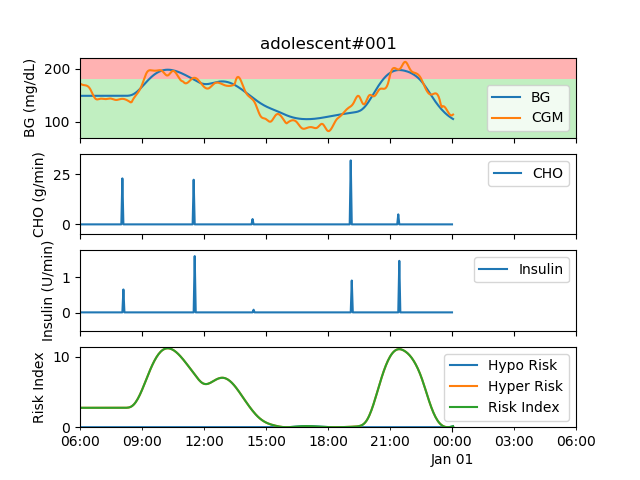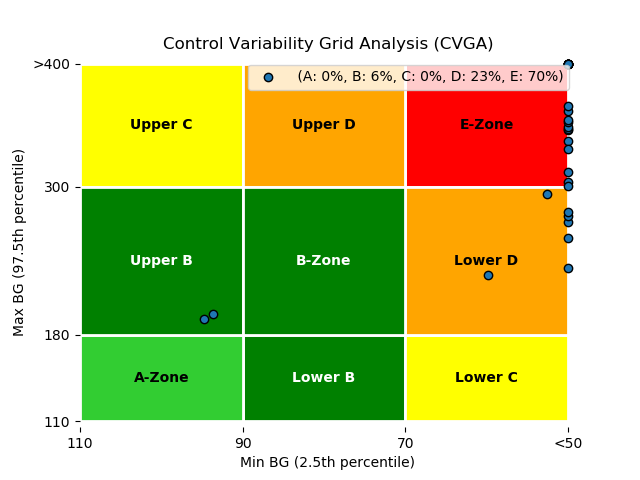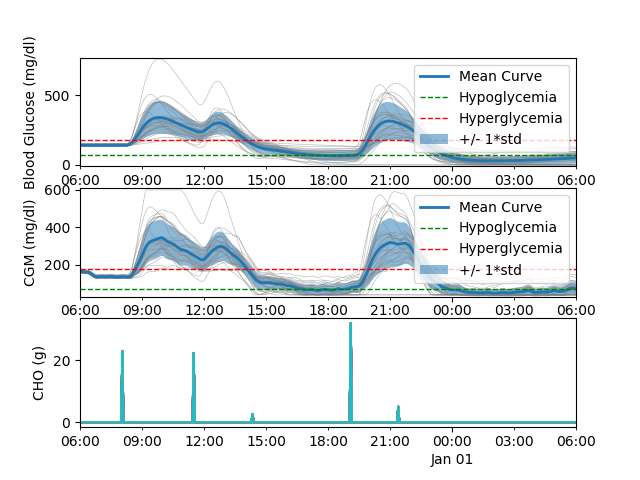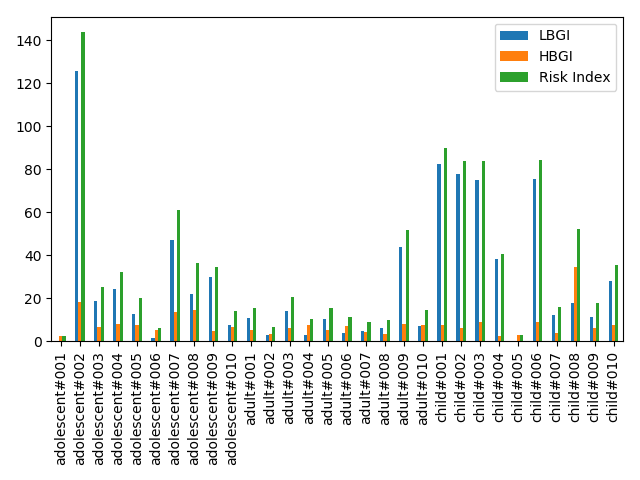A Type-1 Diabetes simulator implemented in Python for Reinforcement Learning purpose
This simulator is a python implementation of the FDA-approved UVa/Padova Simulator (2008 version) for research purpose only. The simulator includes 30 virtual patients, 10 adolescents, 10 adults, 10 children.
HOW TO CITE: Jinyu Xie. Simglucose v0.2.1 (2018) [Online]. Available: https://github.com/jxx123/simglucose. Accessed on: Month-Date-Year.
Notice: simglucose no longer supports python 3.7 and 3.8, please update to >=3.9 verison. Thanks!
Announcement (08/20/2023): simglucose now supports gymnasium! Check examples/run_gymnasium.py for usage.
| Animation | CVGA Plot | BG Trace Plot | Risk Index Stats |
|---|---|---|---|
 |
 |
 |
 |
- Simulation environment follows OpenAI gym and rllab APIs. It returns observation, reward, done, info at each step, which means the simulator is "reinforcement-learning-ready".
- Supports customized reward function. The reward function is a function of blood glucose measurements in the last hour. By default, the reward at each step is
risk[t-1] - risk[t].risk[t]is the risk index at timetdefined in this paper. - Supports parallel computing. The simulator simulates multiple patients in parallel using pathos multiprocessing package (you are free to turn parallel off by setting
parallel=False). - The simulator provides a random scenario generator (
from simglucose.simulation.scenario_gen import RandomScenario) and a customized scenario generator (from simglucose.simulation.scenario import CustomScenario). Commandline user-interface will guide you through the scenario settings. - The simulator provides the most basic basal-bolus controller for now. It provides very simple syntax to implement your own controller, like Model Predictive Control, PID control, reinforcement learning control, etc.
- You can specify random seed in case you want to repeat your experiments.
- The simulator will generate several plots for performance analysis after simulation. The plots include blood glucose trace plot, Control Variability Grid Analysis (CVGA) plot, statistics plot of blood glucose in different zones, risk indices statistics plot.
- NOTE:
animateandparallelcannot be set toTrueat the same time in macOS. Most backends of matplotlib in macOS is not thread-safe. Windows has not been tested. Let me know the results if anybody has tested it out.
It is highly recommended using pip to install simglucose, follow this link to install pip.
Auto installation:
pip install simglucoseManual installation:
git clone https://github.com/jxx123/simglucose.git
cd simglucoseIf you have pip installed, then
pip install -e .If you do not have pip, then
python setup.py installIf rllab (optional) is installed, the package will utilize some functionalities in rllab.
Note: there might be some minor differences between auto install version and manual install version. Use git clone and manual installation to get the latest version.
Run the simulator user interface
from simglucose.simulation.user_interface import simulate
simulate()You are free to implement your own controller, and test it in the simulator. For example,
from simglucose.simulation.user_interface import simulate
from simglucose.controller.base import Controller, Action
class MyController(Controller):
def __init__(self, init_state):
self.init_state = init_state
self.state = init_state
def policy(self, observation, reward, done, **info):
'''
Every controller must have this implementation!
----
Inputs:
observation - a namedtuple defined in simglucose.simulation.env. For
now, it only has one entry: blood glucose level measured
by CGM sensor.
reward - current reward returned by environment
done - True, game over. False, game continues
info - additional information as key word arguments,
simglucose.simulation.env.T1DSimEnv returns patient_name
and sample_time
----
Output:
action - a namedtuple defined at the beginning of this file. The
controller action contains two entries: basal, bolus
'''
self.state = observation
action = Action(basal=0, bolus=0)
return action
def reset(self):
'''
Reset the controller state to inital state, must be implemented
'''
self.state = self.init_state
ctrller = MyController(0)
simulate(controller=ctrller)These two examples can also be found in examples\ folder.
In fact, you can specify a lot more simulation parameters through simulation:
simulate(sim_time=my_sim_time,
scenario=my_scenario,
controller=my_controller,
start_time=my_start_time,
save_path=my_save_path,
animate=False,
parallel=True)- Using default reward
import gym
# Register gym environment. By specifying kwargs,
# you are able to choose which patient or patients to simulate.
# patient_name must be 'adolescent#001' to 'adolescent#010',
# or 'adult#001' to 'adult#010', or 'child#001' to 'child#010'
# It can also be a list of patient names
# You can also specify a custom scenario or a list of custom scenarios
# If you chose a list of patient names or a list of custom scenarios,
# every time the environment is reset, a random patient and scenario will be
# chosen from the list
from gym.envs.registration import register
from simglucose.simulation.scenario import CustomScenario
from datetime import datetime
start_time = datetime(2018, 1, 1, 0, 0, 0)
meal_scenario = CustomScenario(start_time=start_time, scenario=[(1,20)])
register(
id='simglucose-adolescent2-v0',
entry_point='simglucose.envs:T1DSimEnv',
kwargs={'patient_name': 'adolescent#002',
'custom_scenario': meal_scenario}
)
env = gym.make('simglucose-adolescent2-v0')
observation = env.reset()
for t in range(100):
env.render(mode='human')
print(observation)
# Action in the gym environment is a scalar
# representing the basal insulin, which differs from
# the regular controller action outside the gym
# environment (a tuple (basal, bolus)).
# In the perfect situation, the agent should be able
# to control the glucose only through basal instead
# of asking patient to take bolus
action = env.action_space.sample()
observation, reward, done, info = env.step(action)
if done:
print("Episode finished after {} timesteps".format(t + 1))
break- Customized reward function
import gym
from gym.envs.registration import register
def custom_reward(BG_last_hour):
if BG_last_hour[-1] > 180:
return -1
elif BG_last_hour[-1] < 70:
return -2
else:
return 1
register(
id='simglucose-adolescent2-v0',
entry_point='simglucose.envs:T1DSimEnv',
kwargs={'patient_name': 'adolescent#002',
'reward_fun': custom_reward}
)
env = gym.make('simglucose-adolescent2-v0')
reward = 1
done = False
observation = env.reset()
for t in range(200):
env.render(mode='human')
action = env.action_space.sample()
observation, reward, done, info = env.step(action)
print(observation)
print("Reward = {}".format(reward))
if done:
print("Episode finished after {} timesteps".format(t + 1))
breakfrom rllab.algos.ddpg import DDPG
from rllab.envs.normalized_env import normalize
from rllab.exploration_strategies.ou_strategy import OUStrategy
from rllab.policies.deterministic_mlp_policy import DeterministicMLPPolicy
from rllab.q_functions.continuous_mlp_q_function import ContinuousMLPQFunction
from rllab.envs.gym_env import GymEnv
from gym.envs.registration import register
register(
id='simglucose-adolescent2-v0',
entry_point='simglucose.envs:T1DSimEnv',
kwargs={'patient_name': 'adolescent#002'}
)
env = GymEnv('simglucose-adolescent2-v0')
env = normalize(env)
policy = DeterministicMLPPolicy(
env_spec=env.spec,
# The neural network policy should have two hidden layers, each with 32 hidden units.
hidden_sizes=(32, 32)
)
es = OUStrategy(env_spec=env.spec)
qf = ContinuousMLPQFunction(env_spec=env.spec)
algo = DDPG(
env=env,
policy=policy,
es=es,
qf=qf,
batch_size=32,
max_path_length=100,
epoch_length=1000,
min_pool_size=10000,
n_epochs=1000,
discount=0.99,
scale_reward=0.01,
qf_learning_rate=1e-3,
policy_learning_rate=1e-4
)
algo.train()You can create the simulation objects, and run batch simulation. For example,
from simglucose.simulation.env import T1DSimEnv
from simglucose.controller.basal_bolus_ctrller import BBController
from simglucose.sensor.cgm import CGMSensor
from simglucose.actuator.pump import InsulinPump
from simglucose.patient.t1dpatient import T1DPatient
from simglucose.simulation.scenario_gen import RandomScenario
from simglucose.simulation.scenario import CustomScenario
from simglucose.simulation.sim_engine import SimObj, sim, batch_sim
from datetime import timedelta
from datetime import datetime
# specify start_time as the beginning of today
now = datetime.now()
start_time = datetime.combine(now.date(), datetime.min.time())
# --------- Create Random Scenario --------------
# Specify results saving path
path = './results'
# Create a simulation environment
patient = T1DPatient.withName('adolescent#001')
sensor = CGMSensor.withName('Dexcom', seed=1)
pump = InsulinPump.withName('Insulet')
scenario = RandomScenario(start_time=start_time, seed=1)
env = T1DSimEnv(patient, sensor, pump, scenario)
# Create a controller
controller = BBController()
# Put them together to create a simulation object
s1 = SimObj(env, controller, timedelta(days=1), animate=False, path=path)
results1 = sim(s1)
print(results1)
# --------- Create Custom Scenario --------------
# Create a simulation environment
patient = T1DPatient.withName('adolescent#001')
sensor = CGMSensor.withName('Dexcom', seed=1)
pump = InsulinPump.withName('Insulet')
# custom scenario is a list of tuples (time, meal_size)
scen = [(7, 45), (12, 70), (16, 15), (18, 80), (23, 10)]
scenario = CustomScenario(start_time=start_time, scenario=scen)
env = T1DSimEnv(patient, sensor, pump, scenario)
# Create a controller
controller = BBController()
# Put them together to create a simulation object
s2 = SimObj(env, controller, timedelta(days=1), animate=False, path=path)
results2 = sim(s2)
print(results2)
# --------- batch simulation --------------
# Re-initialize simulation objects
s1.reset()
s2.reset()
# create a list of SimObj, and call batch_sim
s = [s1, s2]
results = batch_sim(s, parallel=True)
print(results)Run analysis offline (example/offline_analysis.py):
from simglucose.analysis.report import report
import pandas as pd
from pathlib import Path
# get the path to the example folder
exmaple_pth = Path(__file__).parent
# find all csv with pattern *#*.csv, e.g. adolescent#001.csv
result_filenames = list(exmaple_pth.glob(
'results/2017-12-31_17-46-32/*#*.csv'))
patient_names = [f.stem for f in result_filenames]
df = pd.concat(
[pd.read_csv(str(f), index_col=0) for f in result_filenames],
keys=patient_names)
report(df)- Fixed numpy compatibility issues for risk index computation (thanks to @yihuicai)
- Support Gymnasium.
- NOTE: the observation in gymnasium version is no longer a namedtuple with a CGM field. It is a numpy array instead (to be consistent with its space definition).
- NOTE: Python 3.7 and 3.8 are no longer supported. Please update to >3.9 version.
- Fixed some random seed issues.
- Add PIDController at simglucose/controller/pid_ctrller. There is an example at examples/run_pid_controller.py showing how to use it.
- Controller
policymethod gets access to all the current patient state throughinfo['patient_state'].
- Support customized reward function.
- Added workaround to select patient when make gym environment: register gym environment by passing kwargs of patient_name.
- Added OpenAI gym support, use
gym.make('simglucose-v0')to make the environment. - Noticed issue: the patient name selection is not available in gym.make for now. The patient name has to be hard-coded in the constructor of
simglucose.envs.T1DSimEnv.
Shoot me any bugs, enhancements or even discussion by creating issues.
The following instruction is originally from the contribution instructions of sklearn.
The preferred workflow for contributing to simglucose is to fork the main repository on GitHub, clone, and develop on a branch. Steps:
-
Fork the project repository by clicking on the 'Fork' button near the top right of the page. This creates a copy of the code under your GitHub user account. For more details on how to fork a repository see this guide.
-
Clone your fork of the simglucose repo from your GitHub account to your local disk:
$ git clone git@github.com:YourLogin/simglucose.git $ cd simglucose -
Create a
featurebranch to hold your development changes:$ git checkout -b my-feature
Always use a
featurebranch. It's good practice to never work on themasterbranch! -
Develop the feature on your feature branch. Add changed files using
git addand thengit commitfiles:$ git add modified_files $ git commit
to record your changes in Git, then push the changes to your GitHub account with:
$ git push -u origin my-feature
-
Follow these instructions to create a pull request from your fork. This will email the committers.
(If any of the above seems like magic to you, please look up the Git documentation on the web, or ask a friend or another contributor for help.)


